JOAN MIRÓ! POETRY AND LIGHT – CHIOSTRO DEL BRAMANTE – ROME
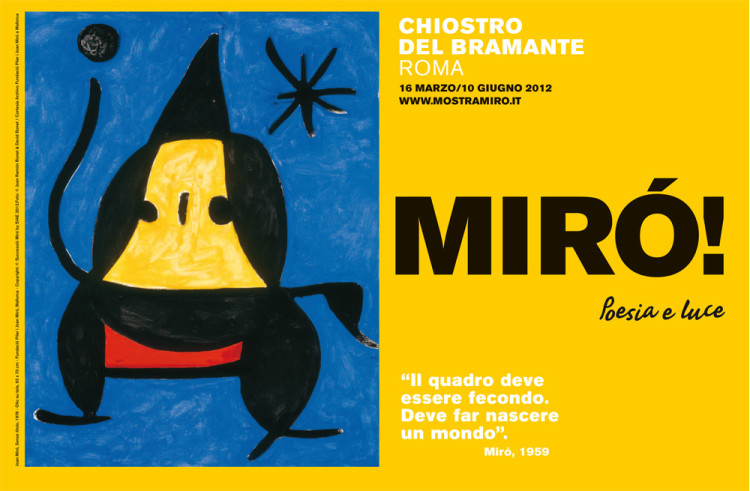
JOAN MIRÓ! POESIA E LUCE
March 16 – August 23, 2012
Chiostro del Bramante – Rome
http://chiostrodelbramante.it/info/miro_poesia_e_luce/
It has been many years since Rome hosted an exhaustive exhibition of the works of Joan Miró (1893–1983), the great Catalan artist who left his unmistakable mark on the European avant-garde art movements.
This exhibition features over 80 works never before shown in Italy, including 50 surprisingly beautiful, large format oil paintings, but also terracotta sculptures, bronzes and watercolours. The masterpieces that can be admired include the oil paintings Woman in the Street (1973) and Untitled (1978); bronzes such as Woman (1967); sketches including that for the mural for Harkness Commons-Harvard University, all from the Fundació Pilar i Joan Miró in Palma de Mallorca, which owns many works by the artist and has granted them on extraordinary loan for their Italian debut.
Sponsored by the Spanish Embassy, the “Miró! Poetry and Light” exhibition has been produced and organized by the Arthemisia Group, 24 ORE Cultura – Gruppo 24 ORE and DART Chiostro del Bramante, in collaboration with the Fundació Pilar i Joan Miró. The exhibition will be held at the Chiostro del Bramante in Rome from 16 March to 10 June 2012.
It is curated by María Luisa Lax Cacho, considered one of the world’s leading experts on Miró, who has wished to illustrate the last stage of the production of the artist’s long life, when he finally made one of his great dreams come true in Majorca in 1956: a huge space of his own in which to work, protected by the peace and silence that only nature could offer him. On occasion of the exhibition Miró’s long-desired studio will be wholly reconstructed within the gallery space.
The artist
Miró was born and grew up in Barcelona and attended La Llotja Academy of Fine Arts, where he studied under Modest Urgell and Josep Pascó. He started drawing when he was very young and his earliest oil painting to have survived is a landscape made in 1908. At 18 years old he exhibited his work at the 6th International Art Exhibition in Barcelona and the following year he started studying at the art college run by Francesc di Galí (1912–15), who taught him how to draw after having felt the model with his eyes closed.
He subsequently studied at the Círcol Artístic de Sant Lluc, where he drew nudes, circus performers and street and port scenes. The style of his early works was influenced by Impressionism, Fauvism, Futurism and Cubism. However, his first trip to Paris, in 1920, brought him closer to Dadaism and, subsequently, Surrealism.
In 1929 Miró married Pilar Juncosa in Palma de Mallorca, with whom he later had a daughter. The same period marked the start of his artistic experimentation, and he turned his hand to lithography, etching, sculpture and painting on tarpaper and glass. He increasingly sought the stimulating tranquillity of the countryside, and a place where he could freely dedicate himself to his work. Consequently, following the outbreak of the Spanish Civil War and a period of exile in France until 1942, he found refuge in Majorca, his mother’s homeland.
In 1954 Miró left his home in Barcelona, moving permanently to Son Abrines in 1956, where he had arranged for the construction of his longed-for studio, which he commissioned from his close friend, the architect Josep Lluís Sert (Barcelona, 1902–83). In order to conserve this much loved property, which was a quintessential creative place for him, in 1980 Miró donated part of it to the city of Palma, and in 1981 the Fundació Pilar i Joan Miró was established.
In 1954 Miró also won the Grand Prize for Graphic Work at the Venice Biennale, and in 1958 the Guggenheim
International Award. However, he had to wait until his old age and the fall of Franco’s regime before he received any acknowledgements in Spain. Consequently, in 1978 he was awarded the Medalla d’Or de la Generalitat de Cataluna; in 1979 the University of Barcelona awarded him an honorary degree (Harvard University had already done so in 1968); in 1980 he received the Gold Medal of Fine Arts from King Juan Carlos of Spain; and in 1983 Spain paid homage to him, with an event organized jointly by the Municipality of Barcelona, the Generalitat de Cataluna, the Ministry of Culture and the Fundació Joan Miró of Barcelona. He died soon after in Majorca and was buried in Barcelona, in Montjuïc cemetery.
The exhibition
The exhibition is divided chronologically and thematically in the nine rooms of the itinerary, where visitors can admire the production of Joan Miró during the last 30 years of his life in Majorca. The story of the master is inextricably bound up with this island that, as his own words convey, represented poetry and light for him.
From the outset of his career Miró maintained that the artist’s objective should focus on large-scale projects, such as murals and other public art works, which also offered the opportunity to work together with architects and craftsmen, relegating easel paintings to a secondary role.
Miró’s public art projects, characterized by a combination of architecture and sculpture, derived in part from his deep admiration for Antoni Gaudí, are represented in the exhibition by works such as Sketch for the Mural of the Terrace Plaza Hotel in Cincinnati (1947) and Sketch for the Harkness Commons Graduate Center, Harvard University (1949–51), and the drawings for his Mural Project for the Union Nation Building in New York (1952-1953).
Miró was in Palma from 1956 onwards, marking the beginning of an intense period of work that also led him to criticize his old sketches and paint over them. Among these paintings and drawings, the exhibition features the aforementioned oil painting from 1908, the earliest one by Miró to have survived, which the artist had covered during this purging. This untitled work thus became the recto of an oil painting made in 1960.
This period is also represented by another untitled work, an oil and acrylic on canvas depicting a figure, a sort of doll, in which the disappearance of the artist’s figurative style starts to become perceptible.
During the 1960s and ’70s the images and titles of his works continue to refer to his favourite themes, such as women, landscapes and birds. However, the iconography becomes abstract and the figures are amplified. The coexistence of different styles and techniques gave rise to static works like Mosaic (1966) and others with confused brushstrokes, such as Poem (1966). It was also the period in which Miró set aside his easel and started painting on the floor, walking on his canvases and lying on them, creating sprays and drips, as in Untitled, also made in 1966, using oil, acrylic and black charcoal with red and blue marks.
The 1970s witnessed a series of monochrome landscapes, such as Untitled, painted in 1973, and other substantially monochromatic paintings like the large-format canvases and another series of five later oil paintings, made in 1978 and displayed in a single room, which are blurred, visionary, minimalist, evanescent and animated, and illustrate Miró’s predilection for the black of the American abstract expressionists and Oriental calligraphy.
The artist’s last years – when he painted with his fingers, applying colour with his fists and got to grips with matter painting, spreading the impasto onto plywood, cardboard and recycled materials – are illustrated by works such as Figure, Bird (1976), an oil on glass-paper, wood and nails. The works with ethereal, modulated blue backgrounds, of which several examples are featured in the exhibition, including the intense Untitled (1978), also date from this period of his production.
Finally, it includes several sculptures that are the result of the experiments that the artist made during his lifetime with various materials and techniques, such as collage, object paintings and other works that, as the years progressed, were inspired by what he collected and that otherwise, as he himself wrote, “would be dead things or museum pieces”.
The exhibition includes bronzes such as Woman (1966) and The Tightrope Walker (1969), assemblages like Figures (after 1973), which combines painting and sculpture and is directly descended from the object paintings of the 1930s, and terracotta sculptures, like the mask (Untitled, 1981) and the ceramic head (Untitled, 1981) that belong to a series of pieces that Miró made together with Hans Spinner, in Saint-Paul-de-Vence.
We have already noted the importance of the workplace for Miró which is why the Studio Sert in which he created some of his masterpieces has been reconstructed in the exhibition space. It includes all the objects, brushes and tools that Miró used, which have been preserved by the Fundació Pilar i Joan Miró.
“The meeting between fantasy and control, prudence and generosity, which perhaps can be considered a feature of the Catalan mentality may explain, at least in part, the fundamental basis of the art and personality of Joan Miró,” Gillo Dorfles wrote in an essay on the Catalan artist. This is the reason why the Renaissance setting of the Chiostro del Bramante offers an ideal counterpoint to the multifarious spirit of Miró and his language, composed of blots, graphic elements, splashes, prints, abrasions, stitches and nails.
The technical sponsors of the event are Samsung, a world leader in the research and development of digital technology, and Acqua Sangemini, the official water of the exhibition.
Press offices
Arthemisia Group
Adele della Sala – ads@arthemisia.it – M +39 345 7503572 – press@arthemisia.it – T +39 06 69380306
24 ORE Cultura – Gruppo 24 ORE
Giulia Zanichelli – giulia.zanichelli@24orecultura.com – M +39 335 1852009 – T +39 02 30223739
Barbara Notaro Dietrich – b.notarodietrich@gmail.com – M +39 348 7946585
Chiostro del Bramante, Valentina de Marco, Raffaele Brancato
comunicazione@chiostrodelbramante.it – info@chiostrodelbramante.it
T + 39 06 68809035 – F +39 06 68213516
JOAN MIRÓ! POESIA E LUCE
16 Marzo – 23 Agosto, 2012
Chiostro del Bramante – Rome
http://chiostrodelbramante.it/info/miro_poesia_e_luce/
Era da molti anni che Roma non ospitava una rassegna esaustiva dell’opera di Joan Miró (1893-1983), il grande artista catalano che lasciò un segno inconfondibile nell’ambito delle avanguardie europee.
La mostra presenta oltre 80 lavori mai giunti prima nel nostro Paese, tra cui 50 olii di sorprendente bellezza e di grande formato, ma anche terrecotte, bronzi e acquerelli.
Si potranno ammirare tra i capolavori, gli olii Donna nella via (1973) e Senza titolo (1978); i bronzi come Donna (1967); gli schizzi tra cui quello per la decorazione murale per la Harkness Commons-Harvard University, tutti provenienti da Palma di Maiorca dove la Fundació Pilar i Joan Miró detiene molte opere dell’artista, concesse in via del tutto straordinaria per l’anteprima italiana.
La rassegna si terrà presso il Chiostro del Bramante a Roma dal 16 marzo al 10 giugno 2012. Con il patrocinio dell’Ambasciata di Spagna, la mostra Miró! Poesia e luce è prodotta e organizzata da Arthemisia Group, 24 ORE Cultura – Gruppo 24 ORE e DART Chiostro del Bramante, in collaborazione con Fundació Pilar i Joan Miró.
La curatrice è María Luisa Lax Cacho, ritenuta a livello internazionale tra i maggiori esperti dell’opera di Miró, la quale ha voluto illustrare l’ultima fase della produzione della lunga vita dell’artista, quando egli finalmente concretizzò a Maiorca nel 1956 un suo grande sogno: un ampio spazio tutto suo, dove lavorare protetto dal silenzio e dalla pace che solo la natura poteva offrirgli. In occasione della mostra, lo studio che Miró aveva tanto desiderato è stato ricostruito scenograficamente all’interno degli spazi espositivi scenograficamente all’interno degli spazi espositivi.
“L’incontro di fantasia e di controllo, di oculatezza e di generosità, che forse si può considerare una caratteristica della mentalità catalana, può spiegare, in parte almeno, la base fondamentale dell’arte e della personalità di Joan Miró”. Così ha scritto Gillo Dorfles in un suo saggio sull’artista catalano. E’ per questo che pare oltremodo opportuna la cornice rinascimentale del Chiostro del Bramante quale contrappunto allo spirito multiforme di Miró e al suo linguaggio fatto di macchie, grafismi, spruzzi, impronte, abrasioni, suture e chiodi.
Sin dal principio della sua attività Miró ritenne che l’obiettivo dell’artista dovesse concernere progetti di grande portata, come i murali e altri lavori d’arte pubblica che offrivano anche l’opportunità di collaborare con architetti e artigiani, lasciando alla pittura da cavalletto una posizione secondaria. I progetti d’arte pubblica di Miró sono caratterizzati invece da una sintesi tra architettura e arti plastiche, derivata anche dalla sua profonda ammirazione per Antoni Gaudí. Abbandonato del tutto il cavalletto, Miró dipinge a terra, cammina sulle proprie tele, vi si stende sopra producendo spruzzi e gocciolamenti, fino a passare gli ultimi anni di attività dipingendo con le dita, stendendo il colore con i pugni e cimentandosi nella pittura materica, spalmando gli impasti su compensato, cartone e materiali di riciclo.
Il catalogo è pubblicato da 24 ORE Cultura – Gruppo 24 ORE e presenta saggi di Elvira Cámara, María Luisa Lax Cacho, Josep Luís Sert e due interviste di Joan Miró realizzate da Yvon Taillandier.
Uffici stampa
Arthemisia Group
Adele della Sala – ads@arthemisia.it – M +39 345 7503572 – press@arthemisia.it – T +39 06 69380306
24 ORE Cultura – Gruppo 24 ORE
Giulia Zanichelli – giulia.zanichelli@24orecultura.com – M +39 335 1852009 – T +39 02 30223739
Barbara Notaro Dietrich – b.notarodietrich@gmail.com – M +39 348 7946585
Chiostro del Bramante, Valentina de Marco, Raffaele Brancato
comunicazione@chiostrodelbramante.it – info@chiostrodelbramante.it
T + 39 06 68809035 – F +39 06 68213516
Tutti i giorni dalle 10,00 alle 20,00
Sabato e Domenica dalle 10,00 alle 21,00
(la biglietteria chiude un’ora prima)
L’ingresso omaggio è valido per minori di 6 anni
, un accompagnatore per gruppo
, due accompagnatori per scolaresca, giornalisti accreditati, soci ICOM, un accompagnatore per disabile, possessori di Vip Card Arthemisia Group
Informazioni e prenotazioni: Tel. 06.916 508 451
Biglietteria on line
www.mostramiro.it – www.ticket.it/miro/



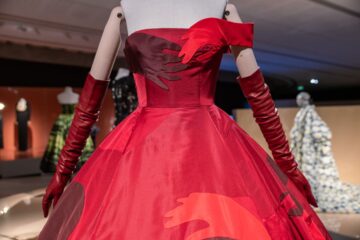
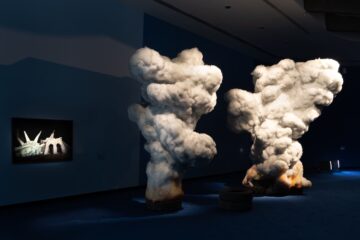
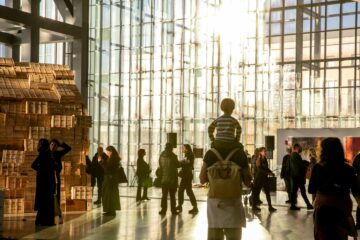
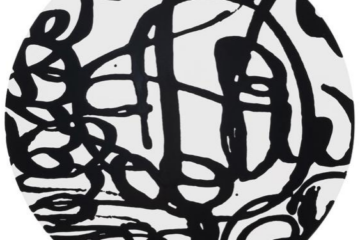

No Comment